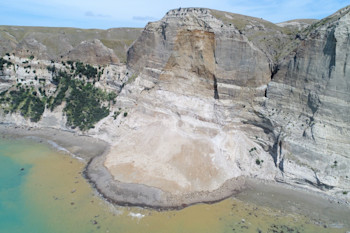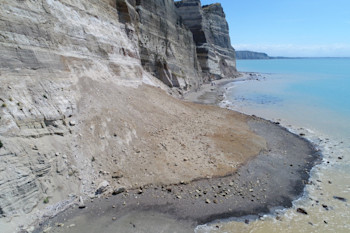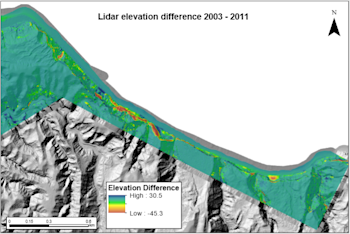
Cliff Collapse at Cape Kidnappers
Landslides are one of the geohazards that GeoNet monitors and last week our landslide team responded to a cliff collapse event at Cape Kidnappers that injured two people.
The cliff collapse occurred on Wednesday 23 January in the early afternoon on the coastal cliffs between Clifton and Cape Kidnappers on the Hawke’s Bay coastline.
The beach along this coastline is used for access to the Cape Kidnappers Gannet Colony by a tourist operation and by day walkers. At the time of the collapse a local tour group was nearby, and two people who were on the beach at the time were injured.
Our landslide team was deployed to the area on Friday to collect data from the site. Landslides occur frequently in New Zealand. However, some pose a bigger threat to human safety than others. Just as we monitor earthquakes, tsunami and volcanic activity, we also monitor landslides to gather data about how the New Zealand landscape is changing, and to inform decisions about keeping the public safe.
“Our team responded to this event to gather data to use in research and for input into future work to evaluate life safety risks so they can be better managed”, says GNS Science engineering geologist Sally Dellow.
“Cliff collapse events in this area are relatively common. Smaller events occur every year. Cliff collapse events of a size similar to the 23 January event probably occur on this stretch of coastline every two to five years”.
The purpose of these missions is to ensure that appropriate information is available to maximise public safety. It’s also to collect reliable landslide data that helps us understand the frequency and magnitude of these events and how vulnerable people are to them.
The team has put together a ‘change model’ using LiDAR (light detection and ranging) data from 2003 and 2011 to show the impact and volume of previous collapses along part of the cliff face.
We use LiDAR to see how much of the land has moved and we can calculate volumes of movement from this data. Unfortunately, the LiDAR data in the below graphic does not extend to the site of this recent cliff collapse but shows land movement along the same stretch of coastline.
Red colours are erosion/loss (source) and blue colours are deposition/gain (what remains of the deposits – most is washed away by the sea).
The beach route to the Gannet Colony is currently closed to the public.
Hastings District Council and their geotechnical consultants are currently assessing the risk and they will advise on how the risk will be managed going forward.
This is an ongoing issue and we will continue to provide support to the council. We are still processing data and this will be made available in due course.
To view previous landslide reports, click here.
Science information - Sally Dellow, GNS Science Engineering Geologist.
Media enquiries - media@gns.cri.nz or 021 574 541





